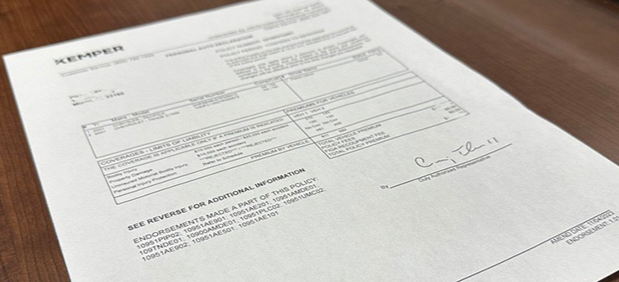Understanding Your Declaration Page
May 30, 2024 by Kemper Auto

What is a declaration page in insurance?
A declaration page or “dec page” is a summary of your auto insurance policy with important information about your insurance coverage. The declaration page provides specific information you (the insured) would need when asking questions or reporting a claim to your insurance company.
To help you read your declaration page, we have put together a guide to assist in navigating your policy.
- Name: The first item listed on the declaration page should be the name and address of the insured and the primary driver (usually you) of the insured’s vehicle.
- Agent/Company: The name and contact information of the insurance agent and/or company that issued the policy.
- Policy number: The policy number is the insured’s specific identifier and will be needed whenever a claim is started.
- Policy period: This is the time period that the policy is active if premiums (the amount you pay for your insurance) are paid. Most policy periods are 6 or 12 months.
- Note that policies typically expire at 12:01 a.m. on the date listed (i.e., coverage is in effect until midnight on the expiration day. Not 11:59 p.m. at the end of the policy date).
- Drivers listed and excluded: All licensed drivers in the household should be listed under the “Additional Drivers” section. People in your household who have a driver's license but are not covered are listed as “Excluded Drivers.”
- As a policyholder, you may choose to exclude drivers who no longer drive, have separate coverage, or are considered high-risk such as teenagers or anyone with a bad driving record.
- Vehicle information: The section includes vehicle information number (VIN), year, make, model, odometer reading, annual mileage and safety features in the vehicle. All details must be correct, so double-check all your information is updated and accurate.
- If you have a lienholder (a loan lender that has a legal claim on the insured’s car), it should be listed here along with the car value.
- Coverages and premiums: The section lists what the policy covers. If coverage has no premium listed next to it, there is no coverage. The declarations page will show the total premium for your policy.
- Forms/Endorsements: Some policy selections require special forms such as proof of homeownership. Any forms along with a record of any changes to your original policy are found in this section of your declarations page.
- Miscellaneous notes: If notes on the policy or car are needed, they will be in this section.
Although each company organizes its declaration page differently, all the items listed above are the basic information that should be on your page.
If you have questions about what address is on file with the insurer, who is covered under the policy, what coverage you selected, which vehicles are covered, or simply want to know your policy number—all you have to do is refer to the declaration page.
Understanding your declarations page is important to know the extent of your coverage and premiums in the case of an accident. By reviewing this guide, you can learn more in-depth details about your policy.
This material is for general informational purposes only. Products, services, and discounts referenced herein are not available in all states or all underwriting companies. All statements are subject to the terms, exclusions and conditions of the applicable policy. In all instances, current policy contract language prevails. Coverage is subject to individual policyholders meeting our underwriting qualifications and state availability. Other terms, conditions and exclusions may apply.
